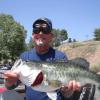I only make spinnerbaits for myself, and a few friends.
When I want to powdercoat a spinnerbait, I fill the lid of the powder jar with powder, and sit it on top of a large piece of visqueen, like a big baggie.
I heat the bait, and then, holding it by the hook, I dip bottom down, and roll as I dip. Then I tap off as much excess as I can.
The sides of the jar lid act as a depth control, and I am careful not to overheat the bait, so I don't get too much powder on the bait.
Sometimes the top isn't coated, so I reheat, hold the bait over the visqueen, and add more powder to the top by pinching some in my hand and sprinkling it over the bait.
It is not very scientific, but I figured out how to make it work. I even add a contrasting color on top sometimes, using the same method.
I even tried Cadman's tap the brush method, but I can't seem to make it work for me. Hat's off to him. His baits are works of art.






